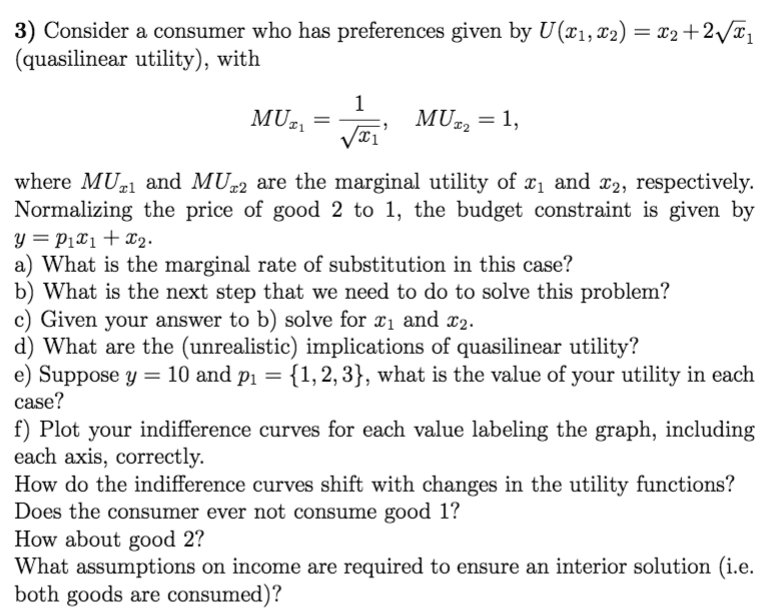a) What is the marginal rate of substitution in this case? b) What is the next step that we need to do to solve this problem? c) Given your answer to b) solve for x1 and x2.
a) What is the marginal rate of substitution in this case? b) What is the next step that we need to do to solve this problem? c) Given your answer to b) solve for x1 and x2.
Microeconomics A Contemporary Intro
10th Edition
ISBN:9781285635101
Author:MCEACHERN
Publisher:MCEACHERN
Chapter6: Consumer Choice And Demand
Section: Chapter Questions
Problem 6QFR
Related questions
Question
100%
The question is in the attached image. Thank you!

Transcribed Image Text:3) Consider a consumer who has preferences given by U(¤1, x2) = x2 +2/%1
(quasilinear utility), with
%3D
1
MUz
MU¤2 = 1,
where MU1 and MU-2 are the marginal utility of x1 and x2, respectively.
Normalizing the price of good 2 to 1, the budget constraint is given by
y = P1X1+x2.
a) What is the marginal rate of substitution in this case?
b) What is the next step that we need to do to solve this problem?
c) Given your answer to b) solve for x1 and x2.
d) What are the (unrealistic) implications of quasilinear utility?
e) Suppose y = 10 and p1 = {1,2, 3}, what is the value of your utility in each
case?
f) Plot your indifference curves for each value labeling the graph, including
each axis, correctly.
How do the indifference curves shift with changes in the utility functions?
Does the consumer ever not consume good 1?
How about good 2?
What assumptions on income are required to ensure an interior solution (i.e.
both goods are consumed)?
Expert Solution
This question has been solved!
Explore an expertly crafted, step-by-step solution for a thorough understanding of key concepts.
Step by step
Solved in 2 steps

Knowledge Booster
Learn more about
Need a deep-dive on the concept behind this application? Look no further. Learn more about this topic, economics and related others by exploring similar questions and additional content below.Recommended textbooks for you









Economics (MindTap Course List)
Economics
ISBN:
9781337617383
Author:
Roger A. Arnold
Publisher:
Cengage Learning